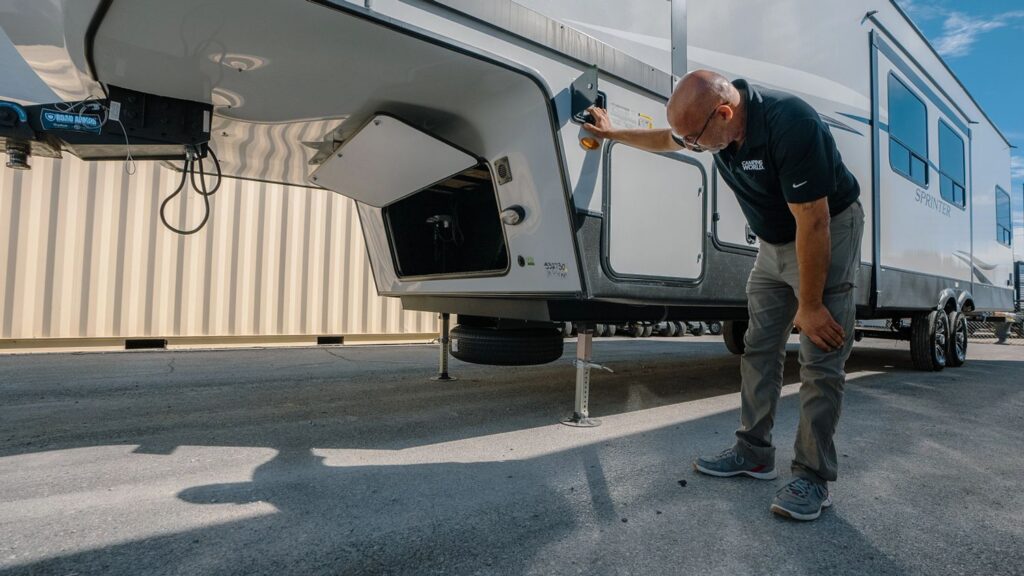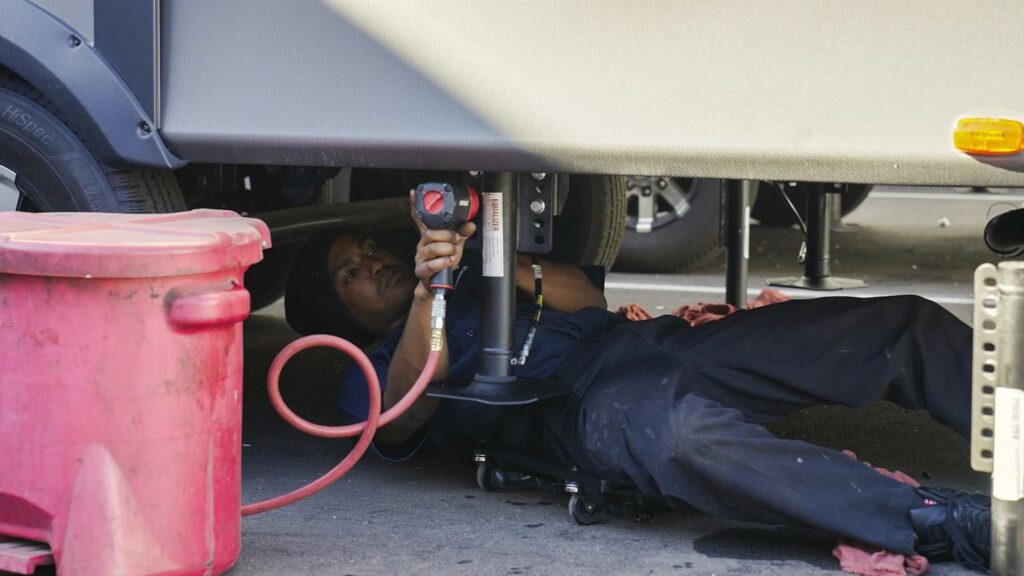Pulling into a perfectly level campsite every trip simply isn’t a reality. And anyone who has spent a night fighting against gravity as they try to sleep knows the value of RV leveling systems.
These allow you to adjust your RV’s level for more comfortable sleeping and safer movement inside. Let’s look at everything new RVers should know about RV leveling systems.
Types of RV Leveling Systems
Most small campers and travel trailers require manual leveling — leveling blocks, tire ramps, camper levelers — before they can be stabilized using scissor jacks or electric stabilizing jacks. Automatic leveling systems are more common on fifth wheels and motorhomes.
Let’s look at the differences between manual and auto RV leveling systems:
Manual Leveling Systems

Photo by Camping World
Most manual leveling systems are set on the ground to create an elevated platform for your RV tires. Depending on the site, you may need differing block heights on each side to bring the floor closer to level.
Here are some of the most popular manual leveling systems we offer:
- Leveling blocks
- Tiered tire ramps
- The Andersen Camper Leveler
Leveling blocks provide the most flexibility of these three options. A set of 10 allows you to stack up to three blocks high on one side of your RV and up to two blocks high on the other. The best method for utilizing leveling blocks is to create a pyramid shape that interlocks the blocks for better strength and stability.
Here’s an example:

Photo by Camping World
Tire ramps and the camper leveler can be deployed more quickly, but they don’t provide as much flexibility as leveling blocks. They also have the added risk of rolling off the high side (tire ramps especially) if you drive past the highest tier.
With all manual leveling systems, the final step for travel trailers is to extend your manual or electric stabilizing jacks. Unless approved by the jack manufacturer, only the manual hand tool should be used on manual jacks. Some jack manufacturers allow the use of a drill, but if they do, impact driver drills should never be used.
Technician Tip: Stabilizing jacks and leveling systems are only meant to stabilize or level up the unit. They should never be used to lift it off of the ground.
An RV Auto Leveling System

Photo by Camping World
Automatic leveling systems are more commonly found on motorhomes and fifth wheels. Most feature hydraulic landing legs that operate independently to level your RV from front to back and left to right.
Others utilize air ride suspension systems that operate similarly to what you’ll find on many commercial buses. When you reach your destination, the air ride system lowers your RV into a level position.
In motorhomes, you’ll often find the controls for your auto leveling system on the dash to the left of the steering wheel. On fifth wheels, the controls are often on the trailer’s sidewall on the driver’s side, as pictured above.
Consult your owner’s manual for the location and recommended operating procedures for your RV’s automatic leveling system.
How to Level and Stabilize Your RV
As their name suggests, automatic leveling systems take much of the work out of this important step in campsite setup. If your RV isn’t equipped with auto leveling, the video above walks you through the steps for manually leveling and stabilizing your RV.
Want to get more out of your RV? Subscribe to the Camping World YouTube channel, and never miss a video.
How to Maintain Motorhome Leveling Systems

Photo by Camping World
Manual RV leveling systems don’t really require regular maintenance. They’ll last longer if you use them correctly, but they must be replaced rather than repaired when they’re compromised.
Automatic RV leveling systems are different. They require regular maintenance to ensure safe, efficient operation. Unlike broken manual leveling systems, some issues can be repaired by a certified RV technician.
But here are some tips for maintaining automatic RV leveling systems for an RV so you can avoid bigger repairs:
- Regularly check fluid levels. The fluid level in the reservoir for your hydraulic leveling system should remain consistent. A significant drop in hydraulic fluid level could signal a leak somewhere in the system.
- Inspect leveling system legs. Visually checking the operation of the leveling system’s legs can help you identify bends or fluid leaks that require maintenance or repair.
- Clean and lubricate. Keep cylinder rods clean to promote trouble-free operation. Lubricate the system regularly according to the manufacturer’s instructions.
A leveling system leg that’s soaked in hydraulic fluid is a clear sign your system requires maintenance. If you notice fluid on the exterior of any of your system’s leveling legs, contact a Camping World Service Center to schedule an appointment.
What Type of Hydraulic Fluid for an RV Leveling System?
The right hydraulic fluid depends on the manufacturer of your RV’s automatic leveling system. Some use Dexron and others require an ATF fluid, but the best path is to consult your owner’s manual for leveling system maintenance recommendations or contact your RV’s manufacturer directly.
Even with the right fluid, you should consult your manual for the system’s recommended fluid level. Overfilling your hydraulic leveling system’s reservoir can be just as harmful to the system as allowing it to operate with a fluid level below the manufacturer’s recommendation.
Leveling your RV is usually the first thing you’ll do when setting up your campsite. Here are a few more resources to help you create the perfect campsite on your next RV trip:
- Everything You Need for an RV Party
- How to Pack for Your First RV Trip
- Here’s Everything You Need to Go Off-Grid Camping
What else do you need to know about RV leveling systems? Let us know in the comments below.
The post Camping World’s Guide to RV Leveling Systems appeared first on Camping World Blog.
By: Tucker Ballister
Title: Camping World’s Guide to RV Leveling Systems
Sourced From: blog.campingworld.com/learn-to-rv/camping-worlds-guide-to-rv-leveling-systems/
Published Date: Thu, 22 Jun 2023 09:00:00 +0000
---------------------------------------------
 CampingSurvivalistHuntingFishingExploringHikingPrivacy PolicyTerms And Conditions
CampingSurvivalistHuntingFishingExploringHikingPrivacy PolicyTerms And Conditions
